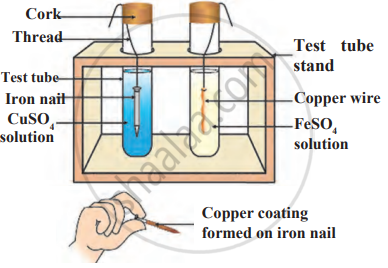Advertisements
Advertisements
Question
A metal A, which is used in thermite process, when heated with oxygen gives an oxide B, which is amphoteric in nature. Identify A and B. Write down the reactions of oxide B with HCl and NaOH.
Solution
Aluminium metal is used in the thermite reaction. When aluminium is heated with oxygen it gives a chemical compound aluminium oxide. Aluminium oxide is amphoteric in nature thus, it acts both as acid and base.
Hence, metal A is aluminium and oxide B is aluminium oxide.
`4"Al"("s") + 3"O"_2("s") -> 2"Al"_2"O"_3("s")`
`"Al"_2"O"_3("s") + 6"HCl"("aq") -> 2"AlCl"_3("aq") + 3"H"_2"O"("g")`
`"Al"_2"O"_3("s") + 2"NaOH"("aq") -> 2"NaAlO"_2("aq") + "H"_2"O"("l")`
APPEARS IN
RELATED QUESTIONS
Give a balanced equation for the reversible catalytic reaction involving nitrogen as one of the reactants.
Select the correct answer for the statement given below:
The catalyst used in the catalytic reaction involving the reactants nitrogen and hydrogen.
Complete the statement by filling in the blank with the correct word:
The metal which reacts with steam and the reaction is reversible is ________.
Explain the following reaction with the balanced equation.
Sodium burns in air
Explain the following reaction with the balanced equation.
Magnesium reacts with dil HCl
Explain the following reaction with the balanced equation.
Sulphur burns in air
Observe the following diagram and identify the type of reaction and write observation.

A metal that exists as a liquid at room temperature is obtained by heating its sulphide in the presence of air. Identify the metal and its ore and give the reaction involved.
An element A reacts with water to form a compound B which is used in white washing. The compound B on heating forms an oxide C which on treatment with water gives back B. Identify A, B and C and give the reactions involved.
Three metal samples of magnesium, aluminium and iron were taken and rubbed with sandpaper. These samples were then put separately in test tubes containing dilute hydrochloric acid. Thermometers were also suspended in each test tube so that their bulbs dipped in the acid. The rate of formation of bubbles was observed. The above activity was repeated with dilute nitric acid and the observations were recorded.
Answer the following questions:
(i) When the activity was done with dilute hydrochloric acid, then in which one of the test tubes was the rate of formation of bubbles the fastest and the thermometer showed the highest temperature?
(ii) Which metal did not react with dilute hydrochloric acid? Give reason.
(iii) Why is hydrogen gas not evolved when a metal reacts with dilute nitric acid? Name the ultimate products formed in the reaction.
OR
Name the type of reaction on the basis of which the reactivity of metals is decided. You have two metals X and Y. How would you decide which is more reactive than the other?
